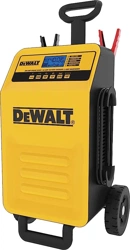Loading ...
Loading ...
Loading ...

English
10
Preparing to Charge
1. Be sure the area around battery is well ventilated while the battery
is being charged.
2. Remove the battery completely from a boat/airplane or any confined
area before charging.
3. If it is necessary to remove battery from a vehicle to charge or to
clean terminals, always remove the grounded terminal from the
battery first. Make sure all accessories in the vehicle are turned off,
so as not to cause an electrical arc.
4. Clean the battery terminals, taking care to avoid getting corrosive
material in your eyes.
5. Add distilled water in each cell until battery acid reaches the
level specified by the battery manufacturer. This helps purge
excessive gas from cells. Do not overfill. For a battery without cell
caps (maintenance free), carefully follow manufacturer’s charging
instructions.
6. Study all battery manufacturer’s specific precautions, such
as removing or not removing cell caps while charging, and
recommended rates of charge.
7. Determine the voltage of the battery to be charged by referring to
the vehicle manual. This unit is for charging a 12 volt battery only.
CHARGER LOCATION
• IMPORTANT: Only use the unit on a flat, level surface to avoid
movement during operation. Take proper precautions to secure the
wheels to avoid shifting or movement before use.
• Locate the charger as far away from the battery as cables permit.
• Never place the charger directly above the battery being charged;
gases from the battery will corrode and damage the charger.
• Never allow battery acid to drip on the charger when reading gravity
or filling the battery.
• Never operate the charger in a closed-in area or restrict ventilation
in any way.
• A marine (boat) battery must be removed and charged on shore.
• Do not set a battery on top of the charger.
CONNECTING THE CHARGER
CONNECTION PRECAUTIONS
• Connect and disconnect output clamps only after removing AC Power
Cord from electric outlet.
• Never allow the clamps to touch each other.
• Attach the clamps to the battery and chassis as indicated in the
appropriate section (“Charging a battery installed in a vehicle” or
“Charging a battery that has been removed from a vehicle”).
FOLLOW THESE STEPS WHEN THE BATTERY IS INSTALLED
IN A VEHICLE
WARNING – A spark near the battery may cause an explosion. To
reduce risk of a spark near the battery:
1. Do not charge the battery while the engine is operating.
2. Position AC and clamp cords to reduce risk of damage by hood,
door, or moving engine part.
3. Stay clear of fan blades, belts, pulleys, and other parts that can
cause injury to persons.
4. Check polarity of the battery posts. The positive post (marked POS,
P, +) usually has a larger diameter than the negative battery post
(marked NEG, N, –).
5. Determine which post of battery is grounded (connected) to the
chassis. If negative post is grounded to chassis (as in most vehicles),
see 6. If positive post is grounded to the chassis, see 7.
6. For a negative-grounded vehicle, connect the positive (red) clamp
from the battery charger to the positive (POS, P, +) ungrounded post
of battery. Connect the negative (black) clamp to vehicle chassis or
engine block away from battery. Do not connect clip to carburetor,
Loading ...
Loading ...
Loading ...
